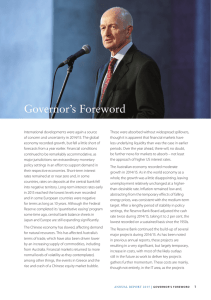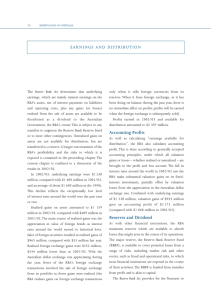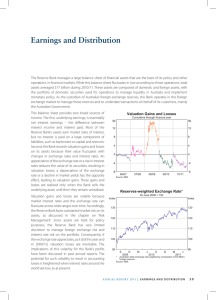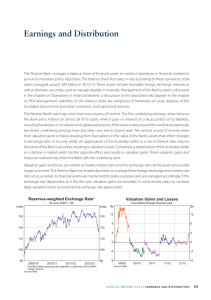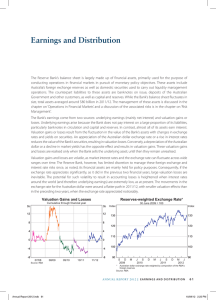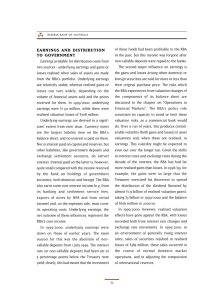Profit and Earnings Distribution
advertisement
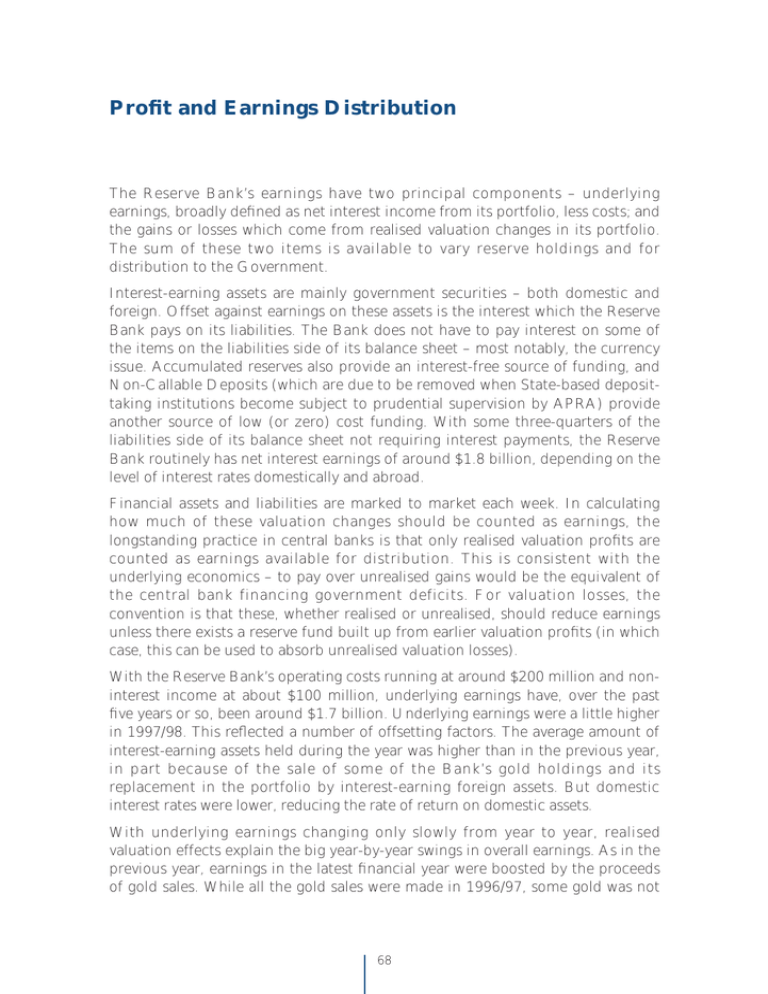
Profit and Earnings Distribution The Reserve Bank’s earnings have two principal components – underlying earnings, broadly defined as net interest income from its portfolio, less costs; and the gains or losses which come from realised valuation changes in its portfolio. The sum of these two items is available to vary reserve holdings and for distribution to the Government. Interest-earning assets are mainly government securities – both domestic and foreign. Offset against earnings on these assets is the interest which the Reserve Bank pays on its liabilities. The Bank does not have to pay interest on some of the items on the liabilities side of its balance sheet – most notably, the currency issue. Accumulated reserves also provide an interest-free source of funding, and Non-Callable Deposits (which are due to be removed when State-based deposittaking institutions become subject to prudential supervision by APRA) provide another source of low (or zero) cost funding. With some three-quarters of the liabilities side of its balance sheet not requiring interest payments, the Reserve Bank routinely has net interest earnings of around $1.8 billion, depending on the level of interest rates domestically and abroad. Financial assets and liabilities are marked to market each week. In calculating how much of these valuation changes should be counted as earnings, the longstanding practice in central banks is that only realised valuation profits are counted as earnings available for distribution. This is consistent with the underlying economics – to pay over unrealised gains would be the equivalent of the central bank financing government deficits. For valuation losses, the convention is that these, whether realised or unrealised, should reduce earnings unless there exists a reserve fund built up from earlier valuation profits (in which case, this can be used to absorb unrealised valuation losses). With the Reserve Bank’s operating costs running at around $200 million and noninterest income at about $100 million, underlying earnings have, over the past five years or so, been around $1.7 billion. Underlying earnings were a little higher in 1997/98. This reflected a number of offsetting factors. The average amount of interest-earning assets held during the year was higher than in the previous year, in part because of the sale of some of the Bank’s gold holdings and its replacement in the portfolio by interest-earning foreign assets. But domestic interest rates were lower, reducing the rate of return on domestic assets. With underlying earnings changing only slowly from year to year, realised valuation effects explain the big year-by-year swings in overall earnings. As in the previous year, earnings in the latest financial year were boosted by the proceeds of gold sales. While all the gold sales were made in 1996/97, some gold was not 68 delivered until September 1997, and the proceeds of these sales are included in the 1997/98 result. These gains represented the difference between the market price of gold sold and the former official price of US$35 per ounce at which it was purchased. Sales of other domestic and foreign securities, which occur in the course of the Reserve Bank’s operations, can crystallise gains or losses. The price of securities sold can differ from the purchase price, and the Australian dollar value of the proceeds of sales of foreign government securities varies with exchange rate movements. Apart from gold, realised gains on assets came to $959 million in 1997/98, mostly from foreign exchange gains. In total, realised gains were $1 507 million in 1997/98, down from $1 990 million in the previous year, which were boosted by the delivery of the bulk of the gold sales, but considerably higher than the average for the past ten years. Sources of earnings available for distribution ($ million) Underlying earnings Realised gains and losses* Earnings available for distribution 1988/89 971 -554 417 1989/90 1 248 -153 1 095 1990/91 1 322 391 1 713 1991/92 1 516 1 038 2 554 1992/93 1 760 2 803 4 563 1993/94 1 556 -48 1 508 1994/95 1 649 123 1 772 1995/96 1 784 702 2 486 1996/97 1 715 1 990 ** 3 705 1997/98 1 767 1 507 *** 3 274 * Charges to earnings in 1993/94 and 1995/96 (and to provisions in the two years to 1989/90), when market values of investments and/or foreign exchange holdings fell below cost, are recorded here as capital losses. ** Of which gold sales contributed $1 637 million *** Of which gold sales contributed $548 million The Reserve Bank’s earnings available for distribution are paid to the Commonwealth Government after any transfers to two reserve funds maintained to deal with contingencies. Earnings available for distribution in 1997/98 were $3 274 million. With the Treasurer’s approval, the net gain on realised gold sales has been retained in the Reserve Bank Reserve Fund. With no transfers made to the Reserve for Contingencies and General Purposes, the dividend out of 1997/98 profits was a little more than $2.7 billion, paid in August 1998. 69 Reserve Bank payments to Government ($ million) Earnings available for distribution Transfers to reserves Balance available for Commonwealth Final payment from previous year Interim payment from current year Total payment 1988/89 417 277 140 1989/90 1 095 520 575 486 – 486 140 300 440 1990/91 1 713 210 1991/92 2 554 200 1 503 275 400 675 2 354 1 103 400 1 503 1992/93 4 563 750 1993/94 1 508 – 3 813 1 954 600 2 554 1 508 3 213 – 3 213 1994/95 1 772 – 1995/96 2 486 150 1 772 1 508 200 1 708 2 336 1 572 200 1 772 1996/97 3 705 1997/98 3 274 2 005 1 700 2 136 – 2 136 548 2 726 1 700 – 1 700 1998/99 2 726 Accounting for Profit Following amendment of the Reserve Bank Act 1959, some changes have been made in the way profit is recorded in the accounts. These changes have no effect on underlying earnings or on the amount available for distribution to the Government. The changes relate solely to the treatment of asset revaluations. General accounting standards require revaluations of current assets to be taken directly to the Profit and Loss Account, even if the gains are unrealised. This concept of profit differs from the long-established and well-accepted view for central banks, noted above, that only realised valuation gains should be available for distribution to the Government. In previous years, the Auditor-General acknowledged that there was a conflict between the accounting standard and the profit distribution criteria, and accepted that, as the Reserve Bank Act 1959 required all profits (excluding additions to reserves) to be distributed to the Government, it was legitimate to calculate profits in accordance with the central bank convention, bringing to account only realised valuation effects. The difference between accounting standards and the Reserve Bank’s profit-distribution policy was handled by audit qualifications to the accounts. The Reserve Bank Act 1959 has now been amended, specifically incorporating the longstanding principles regarding valuation effects as a requirement. With this requirement in place, there is no impediment to applying general accounting principles (although there will be a difference between profits – calculated according to general accounting principles – and earnings available for distribution). Accounting profits now include all changes (both realised and unrealised) in the value of the Reserve Bank’s financial assets during the year, apart from changes in the value of gold holdings, as gold is a long-term non-traded asset. 70 As indicated above, the Reserve Bank Act 1959, as amended, specifically requires that unrealised gains should not be available for distribution to the Government. Therefore, in calculating the amount available for distribution, unrealised gains are deducted from accounting profits and transferred to an unrealised profits reserve; the realised gains attributable to changes in value from earlier years are transferred out of the reserve and added to the amount available for distribution. Realised gains on gold sales have been separately transferred from an asset revaluation reserve to make them available for distribution to reserves or the Government (as noted above, these gains were retained in reserves). The outcome for 1997/98 on this basis is shown in the table below. For comparison, 1996/97 profits are shown on the new basis, and as published in last year’s Annual Report. Accounting profits ($ million) 1996/97 (Annual Report figures) 1996/97 (New basis) 1997/98 3 705 2 730 4 403 n.a. -662 -1 687 Included in profits above 1 637 548 – 10 3 705 3 274 Accounting profit Net transfers to and from unrealised profits reserve Realised gain on gold sales Realised gain on premises Earnings available for distribution 3 705 The Reserve Bank’s 1997/98 Financial Statements are presented in the following pages. 71
